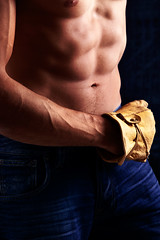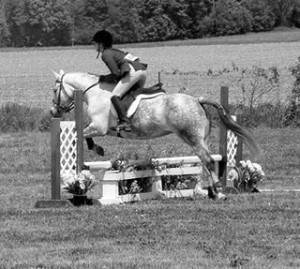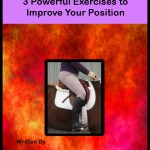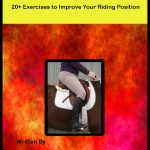Improve Your Position – Get Your Legs Back Part 2
In our first installment Laurie Higgins from Core Connexxions.com told us how to improve your riding position by getting your legs back. In this installment we find exercises to help us develop the strength and flexibility for rider improvement.
Find Your Abs
Being the Pilates instructor that I am, here’s how I teach people to find the transversus abdominis (TA) muscle:

![]() photo credit: Walt Stoneburner
photo credit: Walt Stoneburner
First, you need to completely bypass the rectus abdominis (RA) muscle. Why? Because it is so easy to use, the body goes for it instead and ignores the TA. So we need to skip the RA and focus on the TA. To do this, scoop your abs up and in, just like back in high school when you were trying to impress the opposite sex.
Keep your abs scooped up and in while doing core or abdominal work, such as “crunches” and leg extensions. Lie on your back with your feet flat on the floor and your knees up and about hips’ width apart. With your arms by your sides, inhale and tuck your chin a little. Exhale and scoop up, reaching your arms toward your feet but off the floor by your hips. Look between your knees and inhale. Exhale and roll back down. Repeat five times. Remember to lead with your forehead, not your chin. Only come up far enough to leave the bottom points of your shoulder blades on the floor.
If your belly bulges up while doing this exercise, you’re using the RA muscle. Do your best to avoid using that puppy! If necessary, make exercises easier until you can reliably avoid using the RA muscle. Then begin to increase the difficulty.
In that exercise, your legs were separated. To help engage the TA even more, squeeze your thighs, knees, and calves together. To help do this, you can put a book, a small pillow or a small, kid’s play ball between your knees. If you’re really bowlegged, you’ll need a slightly larger pillow or ball. Once you have established good core strength and stability, you’ll be more efficient in using your legs.
Other Exercises to Improve Your Riding

Even though you need the TA muscle to help you, stretching helps too. Here are a couple of stretches for the quads and the hip flexors to help you. The quads are the four muscles that make up the front of the thigh. That’s why they’re called the “quads”. The “hip flexors” are the same muscles, but we usually mean the upper insertion of those muscles at the point of the hip when we say “hip flexors.”
I’m sure you’ve seen many people at the gym and other places attempting to stretch their quads. You know what I mean. Someone will hold up one foot or ankle behind them and pull their knee back. I hate to say this (actually I love to say it), but most people do it wrong. They either lean forward or arch their lower backs. You just can’t stretch the quad this way. You have to stand up straight and tuck your butt. You might not be able to get your knee very far back (I sure can’t), but at least you won’t be wasting your time – you’ll actually get a good stretch.
![]() photo credit: wbwphotography
photo credit: wbwphotography
Another way to stretch the quads is by lungeing forward on one leg. The back leg with the knee bent is the one stretching. Tuck your butt and straighten your back leg by pushing back through the heel. If you push the middle of your thigh forward with your knee bent, you’ll stretch the quad. If you press the point of your hip forward, you’ll stretch the hip flexor. You can also deepen the lunge and vary the stretch.

![]() photo credit: lululemon athletica
photo credit: lululemon athletica
If you need more tactile help, you can do this in a doorway: You’ll need clear wall space next to the doorway in order to stretch a leg back. Stand in a doorway with your back to the jamb. Your standing leg needs to be about a foot from the jamb, with the knee slightly bent. Press your lower back into the jamb by tucking the pelvis. Then reach back with the toes of the other foot. Now press the heel back and down. If you’ve done this correctly, you should feel a good stretch in the hip flexor.
You can also kneel on the floor and, with a tucked butt and stretching tall, lean back to stretch the quads. Then you can turn this into posting by coming down onto your calves and rising up again, keeping your torso stretched up tall and not leaning forward or back. Use your newly found abs and pelvic floor to help you.
Strengthening
Most of us spend way too much time sitting – sitting in the car (maybe for hours at a time), sitting at our desks, at the computer, watching TV, eating. I could go on. This means that our quads and our hamstrings are shortening and tightening. And the glutes are stretching and “blossoming” – getting bigger and flabbier!
Walking, running, and even standing more will help tighten the glutes by using them. This will help the quads and hamstrings a little, but you

really need to do focus on strengthening them.
Bringing the leg back means using the glutes. Plan to walk at least 20 minutes a day, preferably twice a day. Some other things you can do is back leg raises while standing at the copier or waiting in line (as long as you have clearance and you aren’t going to kick someone). Do leg raises while brushing your teeth. Just tightening the glutes while you’re standing will help.
Try this while brushing your teeth: Stand up tall, with your butt tucked, and raise your right leg out behind you. It can be either straight or bent at the knee. Point the knee down. Lift the leg to a comfortable height and then raise and lower it only a couple of inches every time you count a second for the place you are at your teeth. Take 30 seconds to get from one way-back tooth on the top all the way around the outside to the other way-back tooth on top. Change legs. While brushing the bottom teeth on the outside, lift and lower the left leg 30 times. Now, while coming around the inside of your teeth, lift your right leg slightly out to the side to mimic actually being on a horse, and lift your leg 30 times. Change legs and do the same with the left leg as you brush the insides of the top teeth. You can also try slightly bending the knee of the standing leg.
She also works on dogs, cats, horses and other animals in addition to teaching Pilates and Energywork. Laurie was certified by EQUESTRIAN PILATES® in 2005. Laurie has been riding horses since she was 12 years old, having ridden western, hunt, and dressage. She is now able to keep her horses at home while she deepens her dressage practice on Atticus, her Anglo-Hanoverian gelding, and Ollie, a thoroughbred rescue.
Because Laurie is both an active and life-long rider and certified in Pilates, she is well prepared to help you with your riding or other athletic endeavors through Pilates.
 Try these three powerful exercises to get strengthen your position.
Try these three powerful exercises to get strengthen your position.
